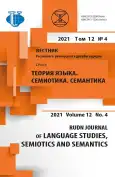Semiophores in Multimodal Communication: Verbal and Visual Representation of Cultural Values. Soviet and British Candy Wrappers of the Latter Half of the 20th Century as a Case Study
- Authors: Vetrova K.O.1, Mishlanova S.L.1
-
Affiliations:
- Perm State University
- Issue: Vol 12, No 4 (2021)
- Pages: 1276-1284
- Section: SEMIOTIC STUDIES
- URL: https://journal-vniispk.ru/2313-2299/article/view/323346
- DOI: https://doi.org/10.22363/2313-2299-2021-12-4-1276-1284
- ID: 323346
Cite item
Full Text
Abstract
The article considers complex semiophore analysis of Soviet and British candy wrappers representing social and cultural development of Soviet and British society in a certain period of time. Examination of non-trivial research material, definition of the term “semiophore” and the development of a complex method of semiophore analysis make the presented research relevant. Semiophores are indicated by the authors as derivative multimodal semiotic objects that represent historical, political and cultural identity in different ways. The authors have examined 53 candy wrappers, among which 30 candy wrappers are of a Soviet and 23 ones are of a British origin. All of them were produced in late 20th century. Candy wrappers being semiophores are considered as a complex of associated, functional, pragmatic, logical and semantic connections. This causes a necessity to develop a complex methodology of semiophores analysis. As a result, a complex method of semiophore analysis has been elaborated. The method has been applied in research of Soviet and British candy wrappers of the latter half of the twentieth century. The authors have concluded that in most cases the verbal and visual components that form the structure of a candy wrapper correspond to each other and actualize the image presented on it. All images presented on the Soviet wrappers can be thematically divided into various groups, for example, some candy wrappers represent crucial historical events, literary characters, cultural phenomena and architectural objects of Russian cities. In general, the images presented on the Soviet candy wrappers perform an educational function, contribute to the formation of cultural, national, political identity and self-identity of Russians. British candy wrappers are characterized by a simple design and usually present the name and look of the product. At the same time, the name of a product has a clear structure and informs the consumer about the manufacturer and the content of the product. Unlike the Soviet candy wrappers, the British candy wrappers were found to be primarily aimed at providing product information and advertising the product. The authors are eager to apply the developed complex methodology to the analysis of other types of semiophores in their further research.
About the authors
Kristina O. Vetrova
Perm State University
Author for correspondence.
Email: vetrova_ko@mail.ru
ORCID iD: 0000-0002-1421-1170
Lecturer of the Department of Linguodidactics of the Faculty of Modern Languages and Literatures
15, Bukireva St., Perm, Russian Federation, 614990Svetlana L. Mishlanova
Perm State University
Email: mishlanovas@mail.ru
ORCID iD: 0000-0003-3332-9753
Doctor of Philology, Professor, Head of the Department of Linguodidactics of the Faculty of Modern Languages and Literatures
15, Bukireva St., Perm, Russian Federation, 614990References
- Bartes, R. (1989). Selected works. Semiotics. Poetics, G.K. Kosikov (ed.). Moscow: Progress. (In Russ.).
- Lotman, Yu.M. (1992). Semiotics of culture and text. Selected articles. Vol. 1. Tallinn: Aleksandra. (In Russ.).
- Pomian, K. (1990). Collectors and Curiosities. Paris and Venice, 1500—1800. Cambridge: Polity.
- Kagan, M.S. (1994). Museums in culture. Voprosy iskusstvoznaniya, 4(94), 445—460. (In Russ.).
- Kalugina, T.P. (2008). Art museum as a phenomenon of culture. St. Petersburg: Petropolis. (In Russ.).
- Bezzubova, O.V. (2016). Museum and the Memory Policy. International Journal of Cultural Research, 3(24), 76—84. (In Russ.).
- Pischerskaya, E.N. (2012). Verbal and visual means of persuasion in banner advertising. ISLU Philological Review, 1(17), 58—63. (In Russ.).
- Tsvetkova, N.V. (2012). The principle of iconicity in polycode advertising discourse [dissertation]. Barnaul. (In Russ.).
- Chernyavskaya, E.V. (2021). Image and visuality in sociocultural dimension. PRAXEMA, 2(28), 96—109. (In Russ.).
- Voroshilova, M.B. (2006). Creolized text: aspects of study. Political Linguistics, 20, 180—189. (In Russ.).
- Novospasskaya, N.V. & Zou, H. (2021). The Formation of Polycode Text Theory. RUDN Journal of Language Studies, Semiotics and Semantics, 12(2), 501—513. doi: 10.22363/2313-2299-2021-12-2-501-513
- Adami, E. & Jewitt, C. (2016). Special Issue: Social media and visual communication. Visual Communication, 15(3), 263—270.
- Andersen, T.H., Boeriis, M., Maagerø, E. & Tonnessen, E.S. (2014). Social Semiotics. Key Figures, New Directions. Abingdon: Routledge.
- Devyatkova, M.I. (2016). Methods applied for analysis of creolized texts. Pedagogicheskoe Obrazovanie v Rossii, 4, 31—34.
- Halliday, M.A.K. (1978). Language as social semiotic: The social interpretation of language and meaning. London: Edward Arnold.
- Hodge, B. (R.I.V.). (2017). Social Semiotics for a Complex World: Analysing Language and Social Meaning. U.K.: Polity Press.
- Oprishch, N.S. (2020). Functioning of English language social advertising creolized texts. Russian Linguistic Bulletin, 2(22), 41—44.
Supplementary files









